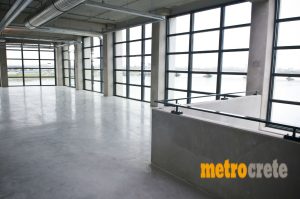Epoxy Coatings: Surface Prep Options for Concrete Floors
Before applying epoxy coatings for concrete floors, the most important step involves surface prep. No matter how good the epoxy quality, adhesion is only as good as the floor surface.
For example, if you have a spot of oil on the floor and you don’t remove it prior to epoxy coating application, the coating goes onto the oil rather than the concrete. Delamination results from improper surface preparation.
 Additionally, any cracks, damaged or spalling areas need repair before applying epoxy.
Additionally, any cracks, damaged or spalling areas need repair before applying epoxy.
- Concrete Etching Liquids – These are liquid and gel etching products. Contractors dilute liquids, apply to floors and then brush it in with a stiff bristle broom. They allow it to sit for 15 minutes or per manufacturer recommendations then wash off with clear water and let floor completely dry.
- Concrete Etching Gels – Referred to as Gel Acid, this is acid contained in a gel. What we like about this product is that it is as effective as shot blasting or grinding for removing contaminants and creating a coarse surface for excellent bonding of epoxy coatings. See the video below or visit Surface Gel Tek for more information and ordering.
- Shotblasting–This is a mechanical process of shooting small steel bearings at concrete to remove bond breakers like oil, paint, adhesives and profile the surface creating increased surface area for epoxy coating application. See Video below.
- Concrete Grinding – This is the process of grinding the concrete surface. One of the advantages is removing the high spots on the floor creating a flat surface. See Video below.
For garage floor epoxy coatings we recommend etching with gelled acid over etching with a liquid acid. Gelled Acids provide much more control. Liquid and Gelled Acid etching are both safe and easy.
Most commercial epoxy coating applications are either shotblasted or ground. Many local tool and equipment rental companies provide shot blasting or concrete grinding equipment.
